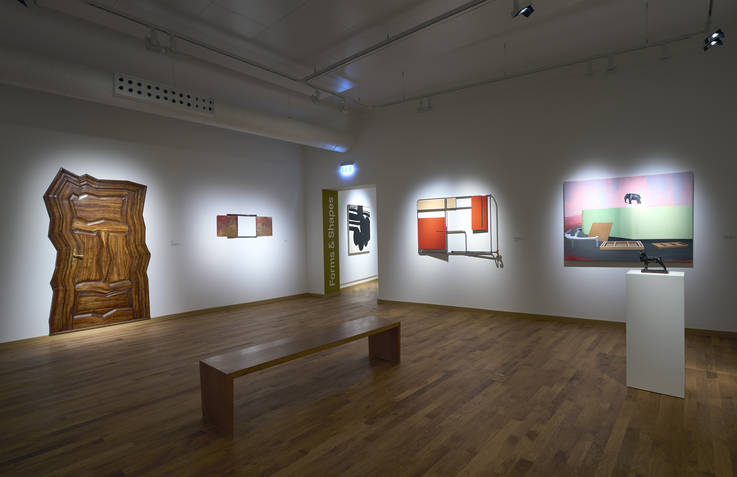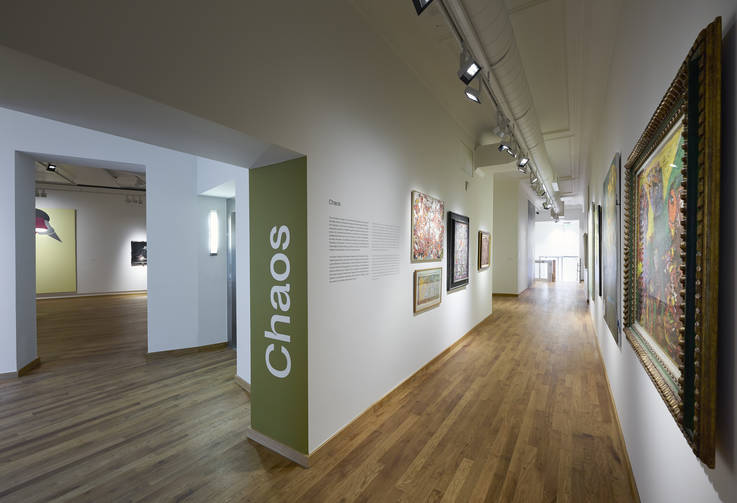The long-awaited day has finally arrived! After almost four years, the permanent exhibition of modern and contemporary art reopened to the public this March after extensive renovation work, including a brand-new parquet floor. We are delighted that the diverse array of works from the collection of modern and contemporary art will once again be on view on the 4th floor of the Nationalmusée um Fëschmaart.
The thematic model
For the new permanent display of our modern and contemporary art collection, we opted for a thematic approach, similar to the manner in which many other art museums around the world choose to present their modern art collections. Rigid classifications according to periods and schools can be limiting, failing to adequately reflect the complex interconnections and links in the history of art. Consequently, describing modern art as a single, linear and evolutionary phenomenon becomes impossible, just as artistic practices do not neatly begin and end in a clear chronological fashion.
When Tate Modern opened in 2000, it was one of the first major museums to deviate from the traditional way of presenting modern art to what they described in their press release as a “radical break with the tradition of exhibiting works in chronological order and by school”. The objective was to showcase the permanent collection of modern art from 1900 onwards, arranged in four thematic groups, with the works on display covering the entire 20th century. This innovative approach not only transformed the way museums present their collections today, but also reshaped our understanding of art history, diverging from the conventional perspective of a single, definitive art canon. Since then, numerous museums around the globe have embraced a similar approach.

From chaos to nature
The five themes we have chosen for Collections/Revelations include: Chaos, Nature, Forms and Shapes, Faces and Colour. They evoke ideas and ways of thinking that are not exclusively tied to specific times or movements in art history. Instead, they serve as overarching concepts that have been continuously explored and questioned by artists across different times and places. In this manner, they form a fitting framework for juxtaposing modern and contemporary artworks, highlighting not only the specific eras and contexts in which the works were created but also drawing attention to how these artworks might relate to and reflect upon our present times.
The themes serve as a guide for our visitors as they explore our collection, designed to encourage reflection while also leaving plenty of room for personal interpretation and associations with the artworks. In this way, we aim to create a dynamic yet stimulating exhibition experience for every visitor, regardless of their familiarity with modern and contemporary art. Instead of following a predetermined route to showcase developments in modern art, as chronological hangings often do, this exhibition encourages visitors to move freely around the space. You don’t have to have seen one room to understand the next, rather, visitors can discover the rooms in the order of their choice.

Then and now
Our extensive collection of modern and contemporary art encompasses various media, with painting being a focal point in the collection’s history. The collection dates back to the origins of the Musées de l’État, initially heavily influenced by the post-war École de Paris, later evolving towards the French Narrative Figuration. In recent decades, our focus has broadened, with an emphasis on avant-garde movements such as Supports/Surfaces and portraiture, among others. Many of the works shown in the exhibition have been added to our collection in the past few years while the space was closed for renovation work, offering a wealth of new discoveries, as implied by the title of the exhibition.
Visitors can, for example, expect a piece by Michel Majerus to engage in dialogue with a work by Natalia Dumitresco, inviting contemplation of chaos amidst the rapid pace of technological change in the 1990s, juxtaposed with Dumitresco’s exploration of post-Second World War cityscapes in Paris and beyond. Giorgio de Chirico’s Piazza d’Italia showcases a geometrically rich architectural composition, echoing the monochromatic shapes and interplay of positive and negative space in Patrick Caulfield’s portrayal of mundane interiors, which hangs right next to it. By placing these diverse works side by side, visitors are prompted to reflect on the continuity of artistic themes, techniques and concepts, revealing the dynamic interaction between past, present and future.
Text: Lis Hausemer- Images: Tom Lucas
Source: MuseoMag N°II 2024
